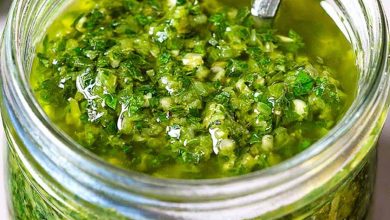Rasam: South Indian Spiced Soup
Rasam is a popular South Indian soup that combines a blend of spices, herbs, and tangy tamarind, creating a flavorful and aromatic dish. This hot and tangy soup is traditionally enjoyed as an accompaniment to rice or can be savored on its own for a comforting meal. With its rich flavors and healthful properties, Rasam is a staple in many South Indian households, known for its digestive benefits and rejuvenating qualities. This vegetarian delight is perfect for those looking to add a bit of spice to their meals, and it’s also an ideal dish for those following plant-based diets.
Ingredients:
- Garlic: 4 cloves, finely chopped
- Ginger: 10 cm piece, peeled and chopped
- Curry Leaves: 20 leaves, with stalks intact
- Peppercorns: 1 heaping tsp
- Dried Red Chillies: 2
- Cumin Seeds: 1 heaping tsp
- Turmeric Powder: 1 tsp
Preparation:
- Prep Time: 10 minutes
- Cook Time: 20 minutes
- Serves: 4
Instructions:
-
Begin by preparing the spice paste: Grind all the ingredients—garlic, ginger, curry leaves, peppercorns, dried red chilies, cumin seeds, and turmeric—together in a blender. Aim for a rough paste consistency, not too fine, to preserve the aromatic quality of the spices.
-
In a pan, add a bit of oil or ghee and sauté the freshly ground spice paste until fragrant, about 2 minutes. The spices should release their full flavor and aroma.
-
Add tamarind extract and water to the pan, mixing well. The amount of water can be adjusted according to your preferred consistency, whether you like it thicker or thinner. Bring this to a boil.
-
Once boiling, reduce the heat and let the rasam simmer for 10-15 minutes. This allows the spices to meld and the flavors to intensify.
-
Optionally, add salt and adjust the seasoning as per your taste. A small pinch of sugar can also be added to balance the tanginess.
-
Garnish with fresh coriander leaves if desired, and serve hot.
Nutritional Information (per serving):
- Calories: ~80 kcal
- Carbohydrates: 15g
- Protein: 2g
- Fat: 1g
- Fiber: 3g
Allergen Information:
This Rasam recipe is naturally free from common allergens such as dairy, gluten, and nuts. However, if you are sensitive to any particular ingredient (such as garlic or curry leaves), be sure to adjust accordingly.
Dietary Preferences:
- Vegetarian: Yes
- Vegan: Yes (ensure that no ghee or animal-based ingredients are used)
- Gluten-Free: Yes
- Dairy-Free: Yes
- Low-Calorie: Yes
Tips and Variations:
- Adjusting Heat: The heat in Rasam primarily comes from the dried red chilies and black peppercorns. You can adjust the spiciness by increasing or decreasing these ingredients based on your tolerance level.
- Tamarind Substitute: If you don’t have tamarind extract, you can use lemon juice for a slightly different tangy flavor. Adjust to taste.
- For a richer flavor: Add a pinch of asafetida (hing) to the spice paste for a deeper umami flavor.
- Serving Ideas: While Rasam is typically served as a soup, it also pairs beautifully with steamed rice, crispy papadams, or a side of vegetable stir-fry.
Conclusion:
Rasam is more than just a soup; it’s a celebration of South Indian spices and herbs. This quick and simple dish provides a flavorful and nutritious option for anyone seeking a hearty vegetarian meal with a touch of spice. With its aromatic paste and refreshing tang, Rasam is perfect for those cooler days or when you’re in need of a light, yet satisfying, dish. Whether you’re a seasoned cook or a beginner, this recipe is easy to prepare and can be enjoyed by all, bringing the authentic taste of South India to your home kitchen.
Enjoy a bowl of homemade Rasam today and let the spices work their magic!




